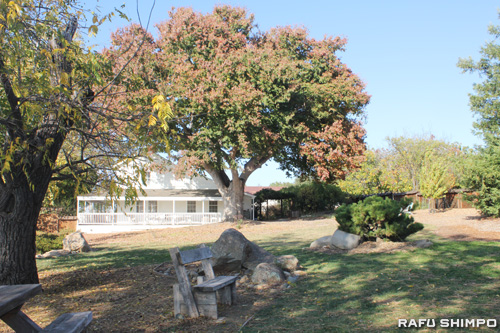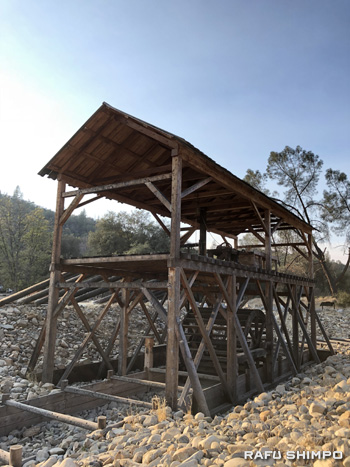
This year marks the 150th anniversary of the first Japanese American settlement on the North American frontier
By JUNKO YOSHIDA
RAFU STAFF WRITER
First of three parts
If not for the relatively fresh flowers and metal cordon surrounding it, a small gravestone on a quiet hill in the California town of Gold Hill might go largely unnoticed. It is the final resting place of a girl, a member of first group of Japanese colonists to settle in North America – and the first Japanese woman to be buried in American soil.
Her name is Okei.
It was 150 years ago that the first Japanese settlers arrived on the American mainland, establishing the first Japanese colony in California. The 22 travelers were from Aizu Wakamatsu in Fukushima Prefecture, located in northern Japan. Following the brutal Boshin Civil War in 1869, the group sought a new life in a distant land.

The grave of Okei, the first Japanese woman to die on American soil, is adorned with gifts from visitors, including flowers and an Akabeko toy cow from her hometown of Aizu Wakamatsu.
At first, their plans bore fruit. The settlers put down stakes and established the Wakamatsu Silk and Tea Farm. The dream was short-lived, however, as the colony collapsed within two years. The colonists dispersed, each seeking his or her own path. Some opted to return to Japan, while others chose to stay in California.
This year marks the sesquicentennial of the Wakamatsu settlement, and their descendants both in California and Japan have shared their feelings and stories with The Rafu Shimpo. Today brings the first a series that looks back 150 years to trace the frontier spirit of those first Japanese colonists.
Gold Hill sits in El Dorado County, near the historic site where James Marshall first found gold in 1849, a discovery spawning the fervor that became California Gold Rush. In these serene surroundings the Japanese colonists chose to put down their American roots.

The small hill top in Gold Hill where the Japanese colonists chose to put down their American roots.
These were not the first people from Japan to travel to America. There had been several who came before, for one reason or another. In 1841, Manjiro Nakamura – who became known as John Manjiro – found himself alone and adrift in the Pacific during a fishing trip. He was rescued by an American whaling ship that brought him to the United States.
In 1851, shipwrecked Hikozo Hamada was rescued by a passing American ship and taken to the mainland. He eventually became the first Japanese to be naturalized as an American citizen, under the name Joseph Heco.
Other than these individual cases, however, the Aizu Wakamatsu settlers are believed to be the first established group of Japanese immigrants to North America. Among them were carpenters, farmers, and even a former samurai, presumably with ambitions of a new and better life in America.
In January 1868, Japan fell into conflict with the start of the Boshin Civil War. From Kyushu to Hokkaido, the country endured brutal combat as forces seeking to return central control of the nation to the emperor waged battle against those loyal to the ruling Tokugawa shogunate. When the fighting reached the Aizu region of western Fukushima in October, the local Aizu government suffered heavy losses in a battle near Aizuwakamatsu Castle and surrendered.
One particular group of young samurai, known as the Byakkotai or White Tiger Unit, assumed the castle had been burned, and believing themselves to be isolated, committed seppuku – suicide. Their story is now legend, and is known only because one of the young warriors was unsuccessful in his suicide attempt.
Against this backdrop of war and hardship, the Aizu Wakamatsu group made the decision to seek a new life in a new land, setting their sights on California.
‘They Are Not Serfs, but Free’
An advance party of the Japanese colonists arrived in San Francisco on May 20, 1869 (Meiji 2 by the Japanese calendar). Their arrival was heralded in local newspapers, such as the Daily Alta California, Marysville Daily Appeal and local publications in the San Francisco and Sacramento areas.

The May 27, 1869 edition of the Daily Alta California reported on the arrival of the new immigrants, describing them as “Highly educated and polished gentlemen, with families brought up in the highest refinement.”
Perhaps encountering Japanese people for the very first time, the writer of the article relates some interesting first impressions of the immigrants.
“They are not serfs, but free. They are highly educated and polished gentlemen, with families brought up in the highest refinement,” the story read. “They fully comprehend our laws and usages and will conform to them. It should be understood that the Japanese conduct themselves with dignity.”
“They bring skill and industry to develop our resources,” the story added.
These observations were in stark contrast to attitudes often directed toward the waves of Chinese immigrants who came to California and entered the workforce as the Gold Rush boomed. Indeed, several local newspapers highlighted the dignity of the Japanese and welcomed their arrival.
A Man Named Schnell
The Daily Alta California story made note of the leader of the new Japanese settlers, introducing him as a Prussian who speaks fluent Japanese. He was said to be an interpreting secretary to a Prussian diplomatic minister, having recently worked with Matsudaira Katamori, Lord of the Aizu Domain. Though his exact date of arrival is unclear, U.S. Census records put his age at around 28 years old at the time.
Schnell was known as a merchant and a dealer of European weapons, and Matsudaira was among his customers. Matsudaira appointed the foreigner to the role of military adviser, tasked with teaching his samurai how to use firearms.
So trusted was Schnell by Matsudaira that the powerful samurai gave him a Japanese name – Hiramatsu Buhei – and allowed him to marry another samurai’s daughter, Jou.
With his defeat by imperial forces in the Boshin Civil War, however, Matsudaira had been stripped of power and territory. With little else to lose, the former ruler was open to Schnell’s ideas about America, and saw potential in California. In April 1869, he entrusted Schnell with Aizu’s future. With Matsudaira’s support, Schnell left Japan and headed to the U.S. with his 23- or 24-year-old wife, their daughter Frances, age 1 or 2, a 17-year-old nanny named Okei, and the other Wakamatsu colonists.

Henry Schnell, who helped lead the settlers group to the U.S., stands at the far right with two unidentified Wakamatsu Colony members
California: Land of Silk and Tea
Schnell and his Japanese fellow immigrants arrived in Gold Hill on June 8, 1869, and the Daily Alta reported regularly on their activities. In an article published June 16, 1869, the paper reported on Schnell’s purchase of a ranch from the Graner family, local farmers in Gold Hill. This site later became known locally as the “Wakamatsu Colony.” Still standing at the site today is a farmhouse built by Charles Graner in 1854, after he had settled in Gold Hill in early 1850.

The house sits on the land now known as the Wakamatsu Farm, shaded by a large keyaki tree that the colonists brought from Japan.
The soil of the area was known to be suitable for cultivating mulberry trees and tea. Schnell planned to build houses for each family, and provide them with trees for silk and tea plants. Each family was to cultivate the land, pick the leaves, and deliver the crops to a nearby factory for payment, depending on quality and quantity. There were also plans to export their silk overseas.
An Oct. 24, 1869 Daily Alta story reported that 13 men, women and children had arrived in Gold Hill, bringing the total number of Wakamatsu colonists to 22.
Failing Crops,
and a Colony Collapsed

Sutter’s Mill replica in Marshall Gold Discovery State Historic Park, the historic site where James Marshall first found gold in 1849
The mining process, however, required large amounts of water, with the resulting pollutants – such as iron and sulfur – flowing out of the sites and contaminating the local water. To make matters worse, an unseasonable drought took hold, and the mulberry trees and tea plants died.
The once optimistic outlook for the settlers had evaporated. On Aug. 6, 1871, the Daily Alta reported the collapse of Wakamatsu Colony. The article reported, “The young plants from Japan made an excellent growth at first, but they finally died out.”
Furthermore, the four dollars in monthly income squeezed the budgets of the immigrants, making it hopelessly difficult for them to live and support their families in a foreign country. Schnell left the Wakamatsu Colony with his family, vowing to return to Japan to raise money.
His next moves remain unknown, as there is no record of his relocation to Japan or elsewhere. It was once rumored that he was killed upon returning to Japan, with his eventual whereabouts remaining a mystery.

Photos of some of first Japanese settlers on the North American mainland hang in a historic farmhouse on the former site of the Wakamatsu Colony in the Northern California town of Gold Hill. The group emigrated from their homeland 150 years ago. Acclimating to their new home included visits to a nearby photo studio in Placervill
To be continued.
English Part 2
English Part 3
The Article That Revealed Okei to the World
WAKAMATSU COLONY: A PROMISE FULFILLED
若松コロニー150周年:新年特集号日本語版
若松コロニー150周年:「おけい」報じた最初の記事